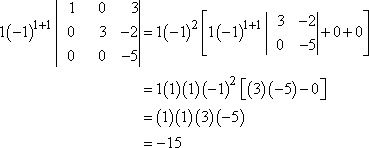
|
|
Minors and Cofactors: Row Operations (page 3 of 3)

No particular row or column looks any better (easier) to expand along than the others. I think I'll do some row- (and column-) operations first, to get some more zeroes in the determinant.

Ah! That's much nicer. Now I can expand along the first row or along the first or second column, and my computations will be much easier than if I'd stuck with the original determinant.
I think I'll go down the first column. The only cofactor I actually need to compute is A2,1:

Then the value of the determinant is -15.
I mentioned that there are other ways to manipulate determinants. You can do the other row operations that you're used to, but they change the value of the determinant. The rules are:
If you interchange
(switch) two rows (or columns) of a matrix A
to get B,
then det(A)
= -det(B).
If you multiply a row
(or column) of A
by some value "k"
to get B,
then det(A)
= (1/k)det(B).
In other words, if you multiply a row (or column) without adding it to another row (or column), then you have to keep track of that multiplier, and divide it off in the end. And if you switch two rows (or columns), you have to change the sign on the answer in the end.
The trouble with these rules is that it's easy to lose track of whatever you multiplied by and how many times you've switched rows, which is why I try to stay away from those operations. But if you're careful, these other operations can be handy. Returning to that last determinant (above), look at these row switches:

I did two row switches, so I've got two sign changes, which takes me right back to the original sign. And now, expanding down the first column, I get:

Did you see that? By manipulating the determinant into triangular form, the value of the determinant turned out to be the product of the values on the diagonal (times the two sign changes, which didn't actually change anything).
Multiplying along the diagonal is much simpler than doing all the minors and cofactors. Given the opportunity, it is almost always better to do row operations and only then do the "expansion". Unless you have an instructor who absolutely insists that you expand determinants in their original form, try to do some row (and column) operations first. If you're having to do determinants by hand, doing operations first will make your life a little less messy.
We've already seen some determinant rules. Two more are as follows:
For matrices A and B, det(AB) = det(A)det(B).
If A is n-by-n, then det(kA) = kndet(A).
We have also seen that the determinant of a triangular matrix C is just the product of the elements on the diagonal. This tells us that the determinant of the identity matrix I is det(I) = 1. And this leads to a sometimes-useful result:
Any invertible matrix A has an inverse matrix A-1 such that (A)(A-1) = (A-1)(A) = I. Since det(AA-1) = det(I) = 1, then, whatever the value of det(A) is, the value of det(A-1) must be the reciprocal of det(A). For instance, if det(A) = 2/3, then det(A-1) = 3/2, so det(AA-1) = det(A)det(A-1) = (2/3)(3/2) = 1 = det(I).
But what if A isn't invertible? Think about it: What number has no reciprocal? The number zero. The only value for det(A) which won't allow for A to be invertible is zero. From this we get the following rule:
If a matrix A has no inverse, then det(A) = 0, and vice versa.
You may be asked at some point to "determine if the following matrix is invertible by using determinants". The question will be asking you to remember the above rule, and to see if the determinant is zero or not. You will not be expected actually to find the inverse.
If you're not going much further in mathematics, you may be able to get away with having your calculator do most or all of your determinant computations for you. But if you're planning on going on (for instance, to differential equations or linear algebra), then make sure you learn how to do determinants by hand. You will almost certainly need the skill.
Original URL: https://www.purplemath.com/modules/minors3.htm Copyright 2009 Elizabeth Stapel; All Rights Reserved.
Terms of Use:
http://www.purplemath.com/terms.htm